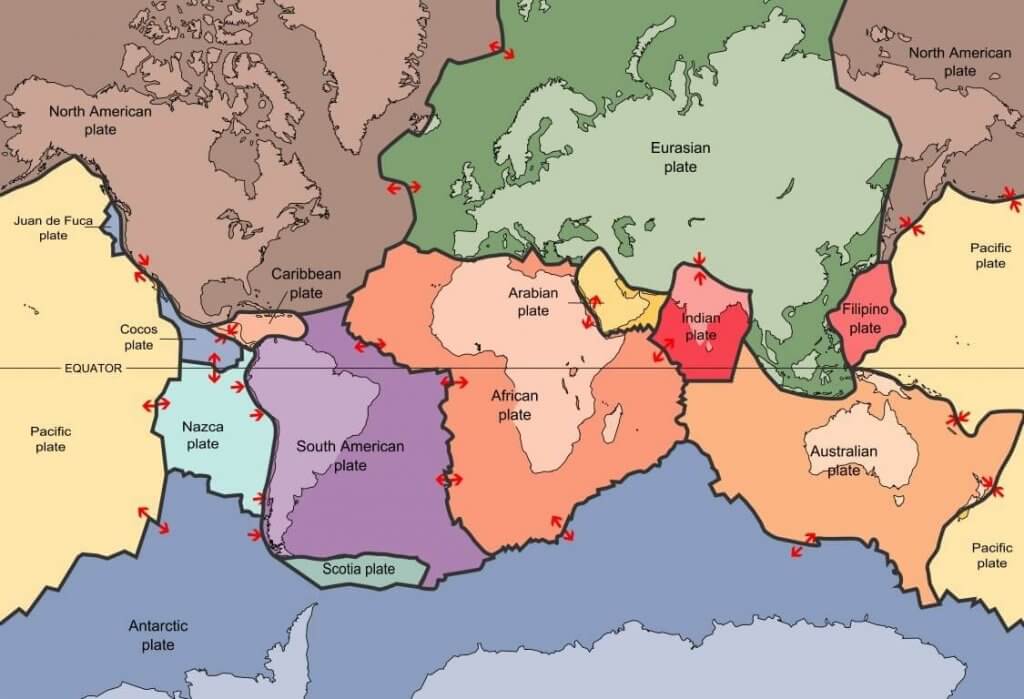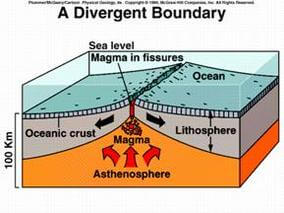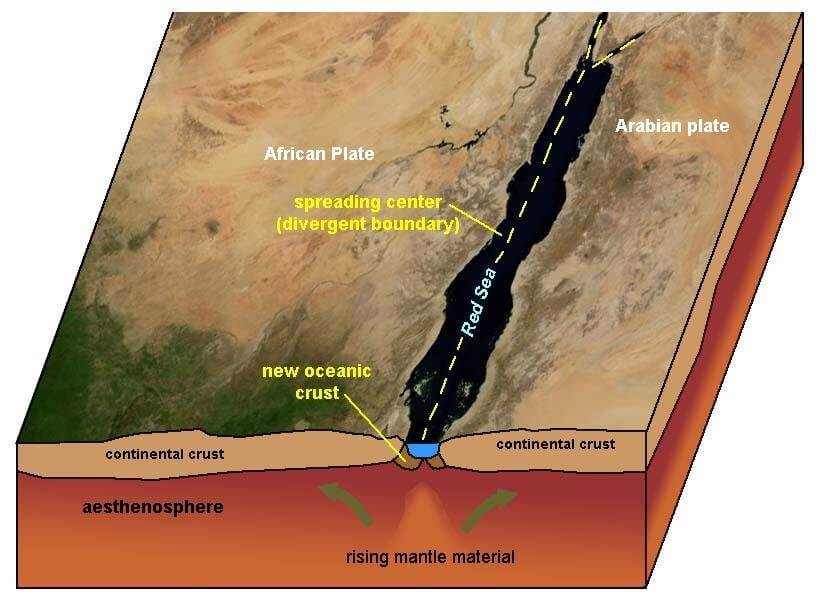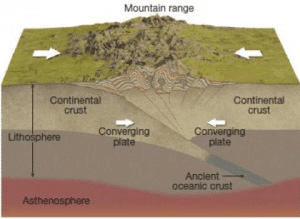The term plate tectonics was first used by Tuzo Wilson, of the University of Toronto but the Plate Tectonics theory was first published by W.J Morgan of the Princeton University in 1962.
Plate tectonics is a scientific theory describing the large-scale motion of 7 large plates and the movements of a larger number of smaller plates of the Earth‘s lithosphere, over the last hundreds of millions of years.
The theoretical model builds on the concept of continental drift developed during the first few decades of the 20th century. The geo scientific community accepted plate-tectonic theory after seafloor spreading was validated in the late 1950s and early 1960s.
Plate Tectonics Theory
- The comprehensive theory which tries to explain most of the dynamism of earth crust and features of the endogenetic forces.
- The development towards the theory began in the 1960s with extensive seafloor mapping
- This theory is based on the 2 principle hypothesis – Arthur Holmes convection current hypothesis, and the concept of seafloor spreading’ advocated by Hess.
- It is an improvement over the Wegener’s continental drift theory and has been considered as the most sophisticated and comprehensive theory about the drift of continents and the expansion of sea floors.
- The lithosphere, which is the rigid outermost shell of a planet (the crust and upper mantle), is broken up into tectonic plates. The Earth’s lithosphere is composed of seven or eight major plates (depending on how they are defined) and many minor plates.
- Where the plates meet, their relative motion determines the type of boundary: convergent, divergent, or transform.
- Earthquakes, volcanic activity, mountain-building, and oceanic trench formation occur along these plate boundaries. The relative movement of the plates typically ranges from zero to 100 mm annually.
Postulates of Plate tectonics theory
- The earth’s interiors according to mechanical rigidity can be classified into –
- Lithosphere
- Asthenosphere
- Mesosphere
- The theory rejects the ideas of SIAL, SIMA based classification.
Lithosphere – The crust and part of the upper mantle = lithosphere (100 km thick, and less dense than the material below it so it “floats”)
Asthenosphere – The plastic layer below the lithosphere = asthenosphere (The plates of the lithosphere float on the asthenosphere)

According to Plate tectonics theory –
- the lithosphere is believed to have been broken into fragments that are floating on a ductile layer called asthenosphere (upper part of the mantle).
- The movement of these plates is attributed to the convention currents being generated in the upper mantle.
- Plates move horizontally over the asthenosphere as rigid units.
- The lithosphere includes the crust and top mantle with its thickness range varying between 5-100 km in oceanic parts and about 200 km in the continental areas.
- The oceanic plates contain mainly the Simatic crust and are relatively thinner, while the continental plates contain Sialic material and are relatively thicker.
- Lithospheric plates (tectonic plates) vary from minor plates to major plates, continental plates (Arabian plate) to oceanic plates (Pacific plate), sometimes a combination of both continental and oceanic plates (Indo-Australian plate).
- The movement of these crustal plates (due to convection currents in the mantle) causes the formation of various landforms and is the principal cause of all earth movements.
- The margins of the plates are the sites of considerable geologic activity such as seafloor spreading, volcanic eruptions, crustal deformation, mountain building, and continental drift.
Lithospheric Plates
A plate is a broad segment of the lithosphere, that floats on the underlying asthenosphere and move independently of the other plates.
Broadly they can be classified into continental plates and oceanic plates.
La Pichon divided the earth into seven major and nine minor plates.
Major tectonic plates
- Antarctica and the surrounding oceanic plate – (Surrounded by divergent boundaries.)
- North American plate – (shifting westwards, velocity 4-5 cm/year. It is half oceanic—half continental)
- South American plate – (shifting westwards, Half continental — half oceanic. 3-4 cm/year)
- Pacific plate – (Truly oceanic plate. Shifting NW 2- 3cm/year)
- India-Australia-New Zealand plate
- Africa with the eastern Atlantic floor plate
- Eurasia and the adjacent oceanic plate – (mostly continental, shifting eastwards. Velocity -2-3cm/year)


Minor tectonic plates
- Arabian plate: Mostly the Saudi Arabian landmass
- Bismark plate (North Bismarck Plate & South Bismarck Plate)
- Caribbean plate
- Carolina plate [straddles the Equator in the eastern hemisphere located north of New Guinea]
- Cocos Plate
- Juan de Fuca Plate (between Pacific and North American plates)
- Nazca plate
- Philippine plate: Between the Asiatic and Pacific plate
- Persian Plate
- Anatolian Plate [or the Turkish Plate is a continental tectonic plate comprising most of the Anatolia (Asia Minor) peninsula (and the country of Turkey)]
- China plate
- Fiji plate [located b/w the Pacific Plate and the Indo-Australia Plate.]




Three types of motion are possible between the plates:
- Separation or divergent or constructive plate margins
- Closing together or convergent or destructive plate margins
- Transform or conservative plate margin

Divergent Boundaries
- A divergent boundaryoccurs when two tectonic plates move away from each other.
- Along these boundaries, lava spews from long fissures and geysers spurt superheated water.
- Frequent earthquakes strike along the rift. Beneath the rift, magma—molten rock—rises from the mantle.
- It oozes up into the gap and hardens into solid rock, forming new crust on the torn edges of the plates.
- Magma from the mantle solidifies into basalt, a dark, dense rock that underlies the ocean floor.
- Thus at divergent boundaries, oceanic crust, made of basalt, is created.
Features of Divergent Boundaries –
- Mid-ocean ridges
- rift valleys
- fissure volcanoes


Continental rift Valleys
- Divergent boundaries can also develop within a continent resulting in a continental rift valley such as The East African Rift, the Baikal Rift Valley, the West Antarctic Rift, and the Rio Grande Rift are Earth’s major active continental rift valleys.


Convergent Boundaries
- When two plates come together, it is known as a convergent boundary.
- The impact of the two colliding plates buckles the edge of one or both plates up into a rugged mountain range, and sometimes bends the other down into a deep seafloor trench.
- A chain of volcanoes often forms parallel to the boundary, to the mountain range, and to the trench.
- Powerful earthquakes shake a wide area on both sides of the boundary.
- If one of the colliding plates is topped with oceanic crust, it is forced down into the mantle where it begins to melt.
- Magma rises into and through the other plate, solidifying into new crust. Magma formed from melting plates solidifies into granite, a light colored, low-density rock that makes up the continents.
- Thus at convergent boundaries, continental crust, made of granite, is created, and oceanic crust is destroyed.
The three types of convergent boundaries are –
- Oceanic–continental convergence,
- Oceanic–oceanic convergence,
- Continental–continental convergence.
Oceanic–Continental Convergence
- Oceanic crust may collide with a continent. The oceanic plate is denser, so it undergoes subduction. This means that the oceanic plate sinks beneath the continent.
- The dense oceanic plate slowly and inexorably sinks into the asthenosphere in the process of subduction. The subducting slab pulls on the rest of the plate—such “slab pull” is probably the main cause of most plate movement, pulling the rest of the plate in after itself, as it were.

Oceanic–Oceanic Convergence
- In collisions between two oceanic plates, the cooler, denser oceanic lithosphere sinks beneath the warmer, less dense oceanic lithosphere. As the slab sinks deeper into the mantle, it releases water from dehydration of hydrous minerals in the oceanic crust.
- As one of the oceanic plates subducts beneath the other, an oceanic trench is formed, shallow and deep-focus earthquakes occur and volcanic activity is initiated with volcanoes forming on the ocean floor.
- With time, a volcanic island arc (such as the Aleutian Islands and the Mariana Islands) develops; such an arc may eventually become a more mature island arc system (such as Japan and the islands of Sumatra and Java in Indonesia are today).



Continental-Continental Convergence
- Continent-Continent (C-C) convergence is formed between two continental plates. When the plates converge, oceanic sediments are squeezed and upthrust between the plates and these squeezed sediments appear as fold mountains along the plate margins.
- The Himalayan Mountains are an example of this type of convergent plate boundary.


Transform Fault Boundaries
A transform fault or transform boundary sometimes called a strike-slip boundary, is a fault along a plate boundary where the motion is predominantly horizontal. Transform Plate Boundaries are locations where two plates are sliding past each other, and there is no creation or destruction of landform but only deformation of the existing landform. The fracture zone that forms a transform plate boundary is known as a transform fault.
In oceans, transform faults are the planes of separation generally perpendicular to the mid-oceanic ridges.
North Anatolian Fault & San Andreas Fault [(Silicon Valley lies dangerously close to the faultline) along the western coast of the USA] is the best example for a transcurrent edge on continents.



Evidences
- Ocean deep drilling- Glomar challenger
- JOIDES- Joint Oceanographic Institutions for Deep Earth Sampling)
- Hot spots
- Paleomagnetism
- Magnetic reversal and seafloor spreading
The significance of Plate Tectonics
- Almost all major landforms formed are due to plate tectonics.
- New minerals are thrown up from the core with the magmatic eruptions.
- Economically valuable minerals like copper and uranium are found near the plate boundaries.
- From the present knowledge of crustal plate movement, the shape of landmasses in the future can be predicted.
- For instance, if the present trends continue, North and South America will separate. A piece of land will separate from the east coast of Africa. Australia will move closer to Asia.
Comparison: Continental Drift & See Floor Spreading & Plate Tectonics
| Continental Drift | Sea Floor Spreading | Plate Tectonics | |
| Explained by | Put forward by Alfred Wegener in the 1920s | Arthur Holmes explained Convectional Current Theory in the 1930s.Based on convection current theory, Harry Hess explained See Floor Spreading in the 1940s | In 1967, McKenzie and Parker suggested the theory of plate tectonics. Morgan later outlined the theory in 1968 |
| Theory | Explains the Movement of Continents only | Explains the Movement of Oceanic Plates only | Explains the Movement of Lithospheric plates that include both continents and oceans. |
| Forces for movement | Buoyancy, gravity, pole-fleeing force, tidal currents, tides, | Convection currents in the mantle drag crustal plates | Convection currents in the mantle drag crustal plates |
| Evidence | Apparent affinity of physical features, botanical evidence, fossil evidence, Tillite deposits, placer deposits, rocks of same age across different continents etc. | Ocean bottom relief, Paleomagnetic rocks, distribution of earthquakes and volcanoes etc. | Ocean bottom relief, Paleomagnetic rocks, distribution of earthquakes and volcanoes, gravitational anomalies at trenches, etc. |
| Drawbacks | Too general with silly and sometimes illogical evidence. | Doesn’t explain the movement of continental plates | ——————— |
| Acceptance | Discarded | Not complete | Most widely accepted |
| Usefulness | Helped in the evolution of convection current theory and seafloor spreading theory | Helped in the evolution of plate tectonics theory | Helped us understand various geographical features. |
Quiz:
Q1. Consider the following statements regarding Plate tectonics.
- The driving force behind plate tectonics is convection in the mantle.
- At transform boundaries, the crust is neither produced nor destroyed as the plates slide horizontally past each other.
- The Mid-Atlantic Ridges are a good example of a convergent boundary.
Which of the above statements is/are correct?
a) 1, 2
b) 1, 3
c) 2, 3
d) 1, 2, 3
Solution: a)
- Divergent boundaries — where new crust is generated as the plates pull away from each other.
- Convergent boundaries — where the crust is destroyed as one plate dives under another.
- Transform boundaries — where the crust is neither produced nor destroyed as the plates slide horizontally past each other.
- Plate boundary zones — broad belts in which boundaries are not well defined and the effects of plate interaction are unclear.
Divergent boundaries occur along spreading centers where plates are moving apart and new crust is created by magma pushing up from the mantle. Picture two giant conveyor belts, facing each other but slowly moving in opposite directions as they transport newly formed oceanic crust away from the ridge crest.
Perhaps the best known of the divergent boundaries is the Mid-Atlantic Ridge.

No comments:
Post a Comment